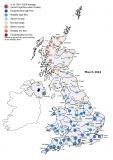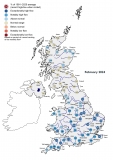Submitted by Steve Turner on
February was a notably dry and exceptionally cold month, with snow and ice causing periodic and at times widespread disruption. Large parts of south-west and eastern England registered monthly mean temperatures more than 1.5°C below average, and the minimum daily temperature of -11.7°C was registered at South Farnborough (Hampshire) on the final day of the month. Under clear skies that accompanied the cold temperatures, it was provisionally the second sunniest February for the UK in a series from 1929. As February progressed, an increasing proportion of the precipitation fell as snow, and disruption of transport networks, schools and hospitals, and power supplies intensified dramatically towards month-end and into early March. Rainfall for the UK was around three quarters of average in February, and two thirds of average across swathes of eastern Scotland and central, southern and south-western England. Despite the dry weather, river flows were generally in the normal range across most of the country. The seasonal recovery of groundwater levels continued at most sites, albeit at a slower rate due to the drier weather of February, and levels were generally in the normal range. With reservoir stocks healthy (above average in almost all major reservoirs) and most river flows and groundwater levels within the normal range, the outlook for water resources has improved relative to the situation at the start of winter. Nevertheless, groundwater levels were low in parts of the Chalk aquifer, and rainfall during the remainder of the recharge season will be influential on the extent of streamflow network contraction and localised water resource stress in these areas in the summer.
Read the full Summary here.



